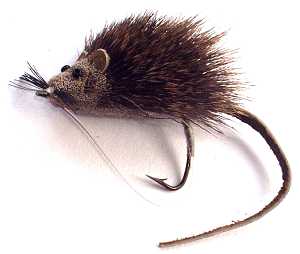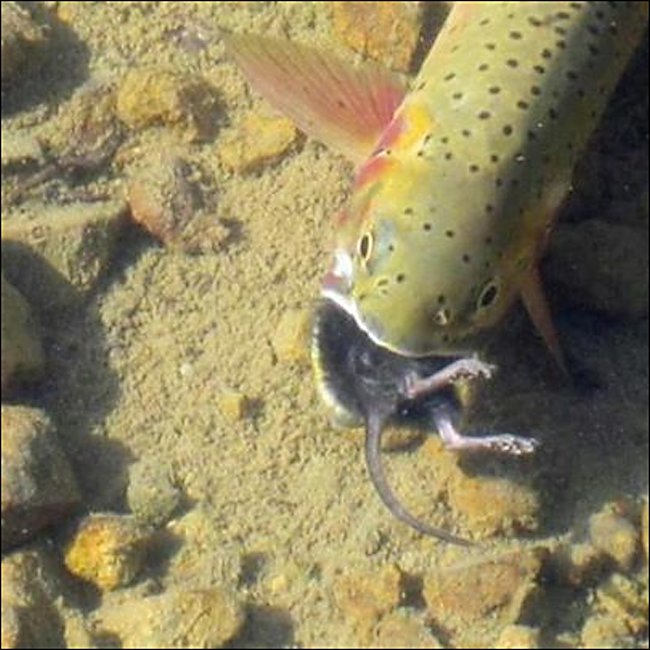The Mouserat Bass Bug
Dave Whitlock designed the original Mouserat Bass Bug for surface fly fishing to attract takes from large trout, salmon and pike.

DEERHAIR BASS BUG FLY PATTERNS. Hook size 6 and 2 - $US each
Once you have detected where these big predator's lairs are all you need to do is swim your mouserat fly over that location. The disturbance in the water surface should hopefully attract their attention and entice them into action. Dave and Emily Whitlock live near Mountain Home, Arkansas, where they conduct the Whitlock Fly Fishing School. Fly fisherman Dave is an author, wildlife artist, world-renowned fly designer, and conservationist. Just have a look at this photo Swimming rodents attract big fish. This is why you should use a mouserat fly.
When bass find the temperatures in the shallows too cold or too hot they will move to deeper water where it is hard to get them to top feed on a floating bass bug, even a juicy mouserat. This is when I switch to streamers like muddlers, zonkers, matukas or woolly buggers. Both species generally migrate to the deeper water during the midday sun and come back to the shallows in the evening. This is the time you will have most success using a Mouserat bass bug. When it gets too cold smallmouth bass stop feeding but largemouth bass will still feed now and again. If you are an ice fisherman you may even be lucky to catch one.
A 7 or 8 weight line is ideal but use 9 or 10 if you do a lot of bass bug fishing near heavy weeds. It should be a floating line but even unsinkable lines can get covered in that green gunge so take a cloth impregnated with line cleaner with you if your line begins to sink. Choose a line that is highly visible to help you locate your bug. Lines appear as dark silhouettes to the fish. It doesn’t matter what color they are.
When the sun goes down the bass seem to disappear for a while. They seem to take a break from feeding. They appear to have a rest before their next round of hunting and eating. Some say it is because the fish need time to adapt to the darker lighting conditions. Others because they now have to travel to different hunting grounds and it takes time to get there. What I have noticed is that I get a lot more takes, an hour or so after sunset. The time period varies depending if it has been a very sunny day or an over cast day. On sunny days the time period is longer. This could be due to the water temperature. Fishing at 2am the bass seem to be much more active than earlier on. The water has cooled down and the Bass appear to wake up. Mice, voles and rats come out at night. This is the ideal time to deploy a mouserat bass bug fly.

The feeding grounds the bass prefer during darkness are different to that during daylight. They are no longer interested in lurking under the cover of weeds, lily pads, old tree trunks and shoreline vegetation, where they can hide in safety and launch an ambush to secure their next meal. The bass now go hunting for natural cover that holds food. This can be the edges bordering around overhanging trees and shrubs, or it can be the edges near deep water. The latter are the best place to fish. Look for the outer edges of weed-beds, the drop off point where the shallow shore line edge changes into deep water, or any submerged steam bed that runs through the flats. The bass slowly cruise up and down these areas foraging for food. They keep on the move and do not stay in one spot unlike their daytime behavior. The problem with night fishing is that accurate casting is more difficult. If you fish in their other night time habitat you are in danger of getting tangled in the over hanging vegetation. The problems may be worth it though as the bigger fish seem to like lurking around these locations.
CUSTOMER'S COMMENT
These flies are usually associated with Bass and Pike fishing but I have found them extremely good for large Brook trout and Salmon. I was fishing in Labrador, Canada on waters that experience migrating lemmings that swim across open water. I suppose you could call this matching the hatch.



Bass Bug books

